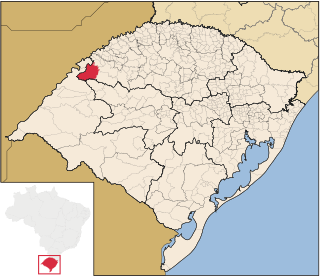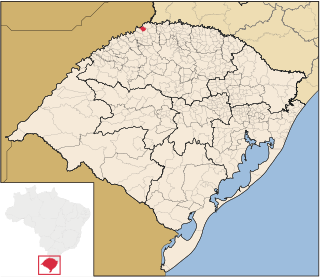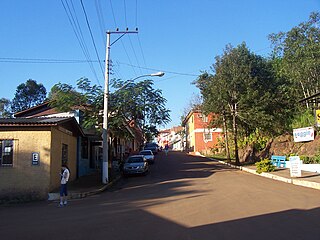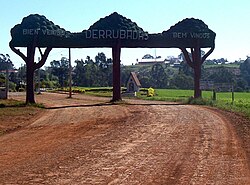
São Nicolau is a municipality of the state of Rio Grande do Sul, Brazil. It was founded in 1626 by Jesuit priest Roque González y de Santa Cruz. The population is 5,208 in an area of 485.32 km². It is located 562 km west of the state capital of Porto Alegre, northeast of Alegrete. The Uruguay River, which forms the border with Argentina, flows along the northwestern part of the municipality.

Santo Antônio das Missões is a municipality in the western part of the state of Rio Grande do Sul, Brazil. The population is 10,050 in an area of 1710.87 km2. Distance from the state capital of Porto Alegre is 534 km west and tens of kilometres east from the Argentine border but the municipality does not border since it is close.

Pirapó is a municipality of the western part of the state of Rio Grande do Sul, Brazil. The population is 2,254 in an area of 295.01 km². The town is situated by the Ijuí River, close to its confluence with the Uruguay River, which forms the border with Argentina. It is located 563 km west of the state capital of Porto Alegre and northeast of Alegrete.

Garruchos is a municipality in the western part of the state of Rio Grande do Sul, Brazil. The population is 2,886 in an area of 799.85 km². Its elevation is 69 m by the Uruguay River. It is located 627 km west of the state capital of Porto Alegre, northeast of Alegrete.

Alecrim is a municipality in the state of Rio Grande do Sul, Brazil.

Crissiumal is a municipality in the state of Rio Grande do Sul, Brazil, with a population of 13,357 inhabitants. It has a fluvial border with Argentina along the Uruguay River.

Doutor Maurício Cardoso is a municipality in the state of Rio Grande do Sul, Brazil. As of 2020, the estimated population was 4,462.

Esperança do Sul is a municipality in the state of Rio Grande do Sul, Brazil. As of 2020, the estimated population was 2,885.
Novo Machado is a municipality in the state of Rio Grande do Sul, Brazil. As of 2020, the estimated population was 3,256.
Porto Lucena is a municipality in the state of Rio Grande do Sul, Brazil. As of 2020, the estimated population was 4,594.

Porto Mauá is a municipality in the state of Rio Grande do Sul, Brazil. As of 2020, the estimated population was 2,352.

Porto Vera Cruz is a municipality in the state of Rio Grande do Sul, Brazil. As of 2020, the estimated population was 1,308.

Porto Xavier is a municipality in the state of Rio Grande do Sul, Brazil. As of 2020, the estimated population was 10,194.

Santo Cristo is a municipality in the state of Rio Grande do Sul, Brazil. As of 2020, the estimated population was 14,216.

Tiradentes do Sul is a municipality in the state of Rio Grande do Sul, Brazil. As of 2020, the estimated population was 5,616.
Tuparendi is a municipality in the state of Rio Grande do Sul, Brazil. As of 2020, the estimated population was 7,810.

The Turvo State Park is a state park in the state of Rio Grande do Sul, Brazil. It protects the last large area of well-preserved Upper Uruguay forest in the state, which is home to several rare or endangered species. The park is best known for the dramatic Yucumã Falls on the Uruguay River, the second-widest in the world by some measures. The falls may be threatened by flooding from the planned Garabí-Panambi Hydroelectric Complex if a 2015 court ruling is overturned.

The Garabí-Panambi Hydroelectric Complex is a planned pair of hydroelectric dams and generating stations on the Uruguay River between Argentina and Brazil. There is controversy over the environmental impact on the fast-flowing river. The prime contractors are trying to avoid public image problems and delays such as those with other recent dams.

The Panambí Dam, or Roncador Dam, is a planned hydroelectric dam and generating station on the Uruguay River between Argentina and Brazil, part of the Garabí-Panambi Hydroelectric Complex. There is controversy over the environmental impact on the fast-flowing river.

The Garabí Dam is a planned dam and generating station on the Uruguay River between Argentina and Brazil, part of the Garabí-Panambi Hydroelectric Complex. There is some controversy over the environmental impact on the fast-flowing river.






















